Abstract
OBJECTIVES: To evaluate whether infliction of peritoneal trauma would promote tumor cell adherence to damaged peritoneal surfaces; to investigate whether peritoneal damage could promote tumor growth of extraperitoneal tumors; and to evaluate whether the amount of trauma correlated with the degree of tumor cell adherence and local and distant tumor growth. BACKGROUND DATA: After potentially curative resection of colorectal carcinoma, the most common site for recurrence is locoregional. We previously demonstrated that surgical trauma induces a cascade of events leading to adhesion formation. The same mechanisms may be responsible for improved tumor cell adherence and growth facilitation in early local recurrence. METHODS: A reproducible rat model was used in which peritoneal damage was inflicted by standardized rubbing of the peritoneum with surgical gauzes of different texture. In the first experiment, tumor cell adherence and growth at traumatized and nontraumatized peritoneal sites were assessed semiquantitatively 3 weeks after perioperative intra-abdominal injection of CC-531 tumor cells. In the second experiment, the effect of peritoneal trauma on ectopic tumor growth was investigated (CC-531 implanted under the renal capsule). In the final experiment, we evaluated how soon after peritoneal traumatization tumor cell adhesion and growth-promoting factors were active and whether they could be passively transferred to naïve nontraumatized abdominal cavities. RESULTS: A significant correlation between the amount of peritoneal trauma and the degree of tumor take at damaged peritoneal surfaces was found (p < or = 0.018). Tumor take at remote peritoneal sites not directly traumatized was also significantly higher after severe trauma than after moderate trauma of the peritoneum (p < or = 0.005). In addition, a significant correlation between the degree of peritoneal trauma and the growth of ectopic tumors under the renal capsule was observed (p < or = 0.009). The final experiment demonstrated that within a few hours after infliction of peritoneal trauma, tumor growth-promoting effects could be passively transferred to naïve recipients. CONCLUSIONS: Surgical trauma is an important factor in the promotion of local recurrence. The enhancing effect of trauma is not restricted to the inflicted site but rather has a generalized character. Avoidance of unnecessary surgical trauma by using gentle techniques and materials is therefore indicated.
Full text
PDF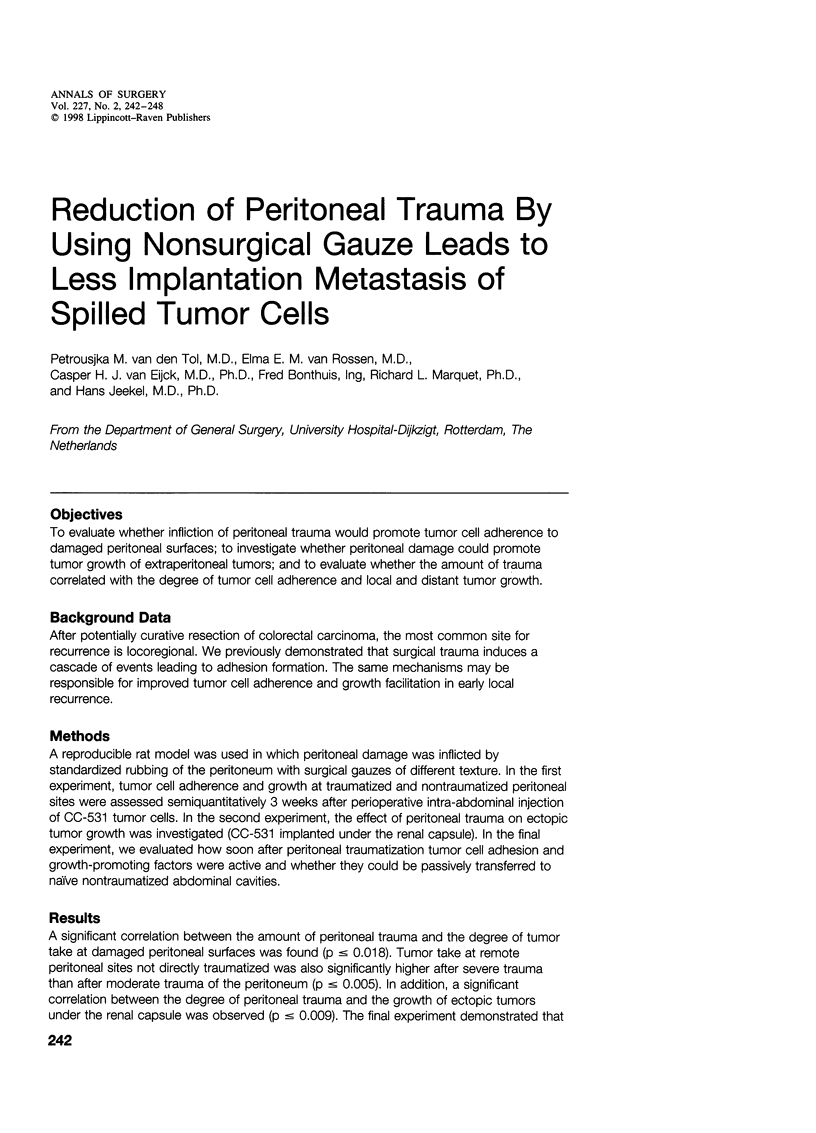
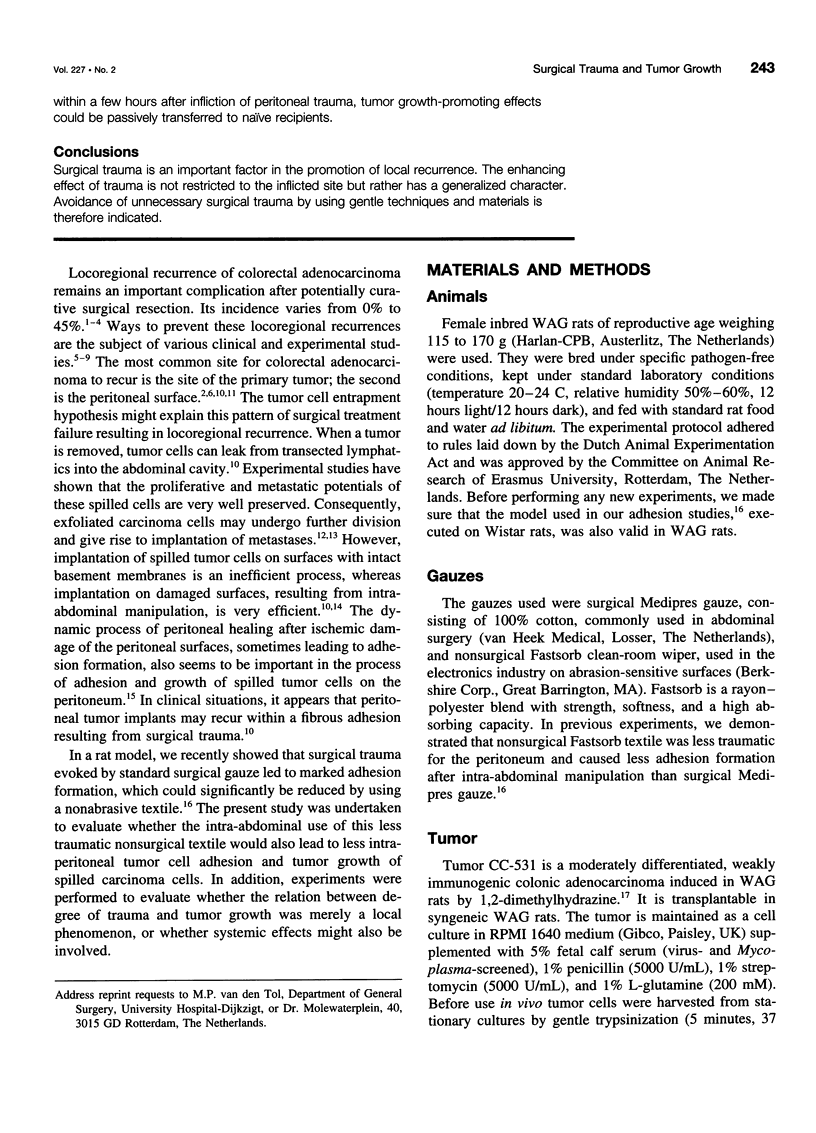
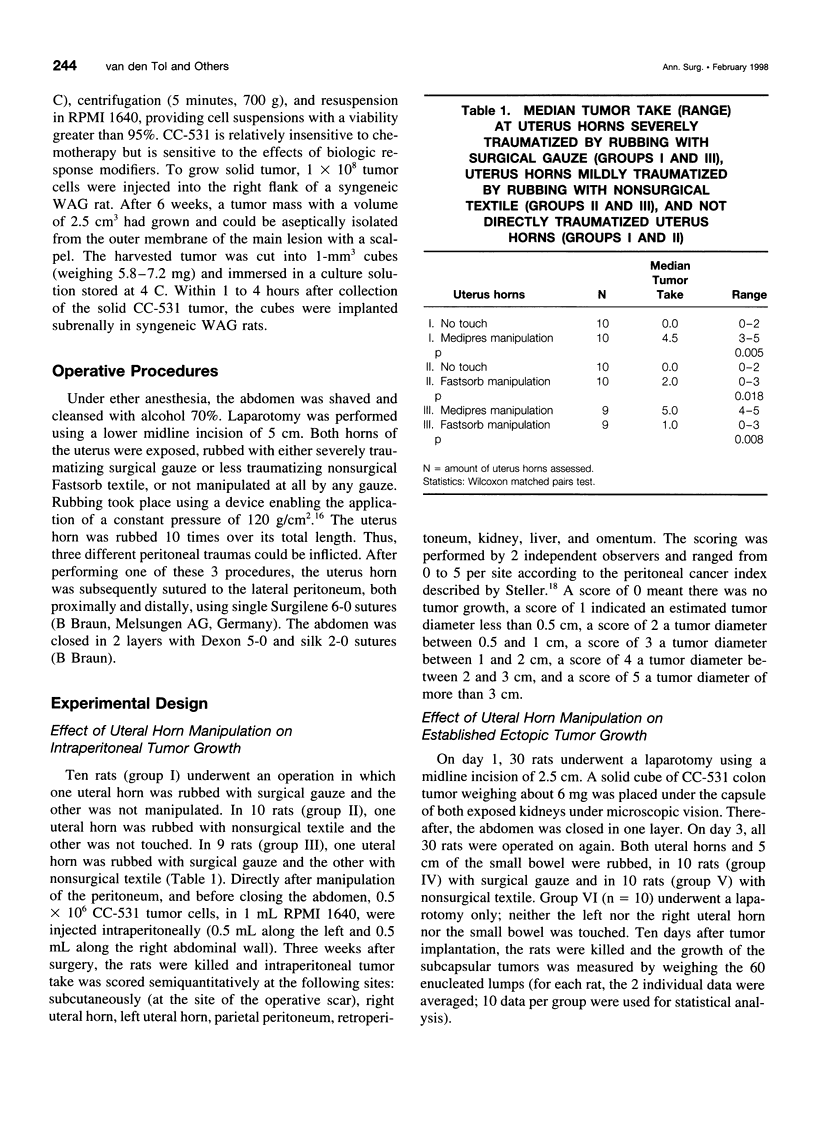
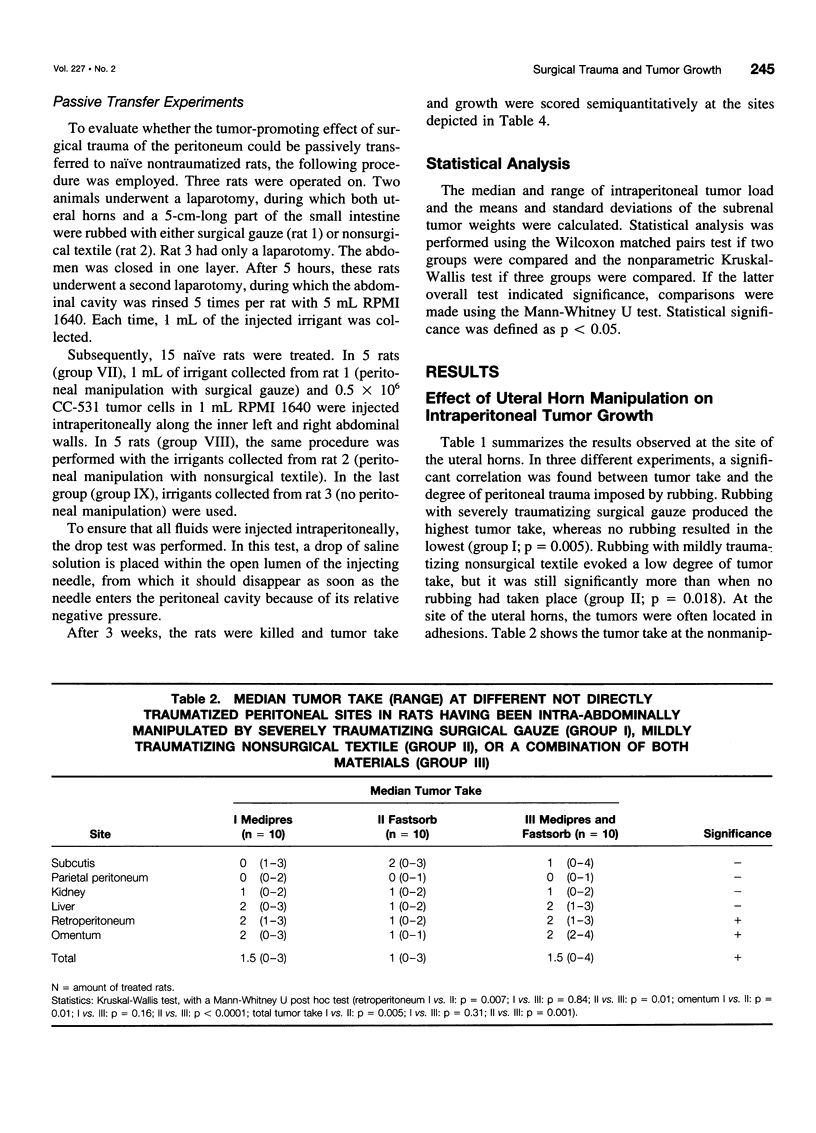
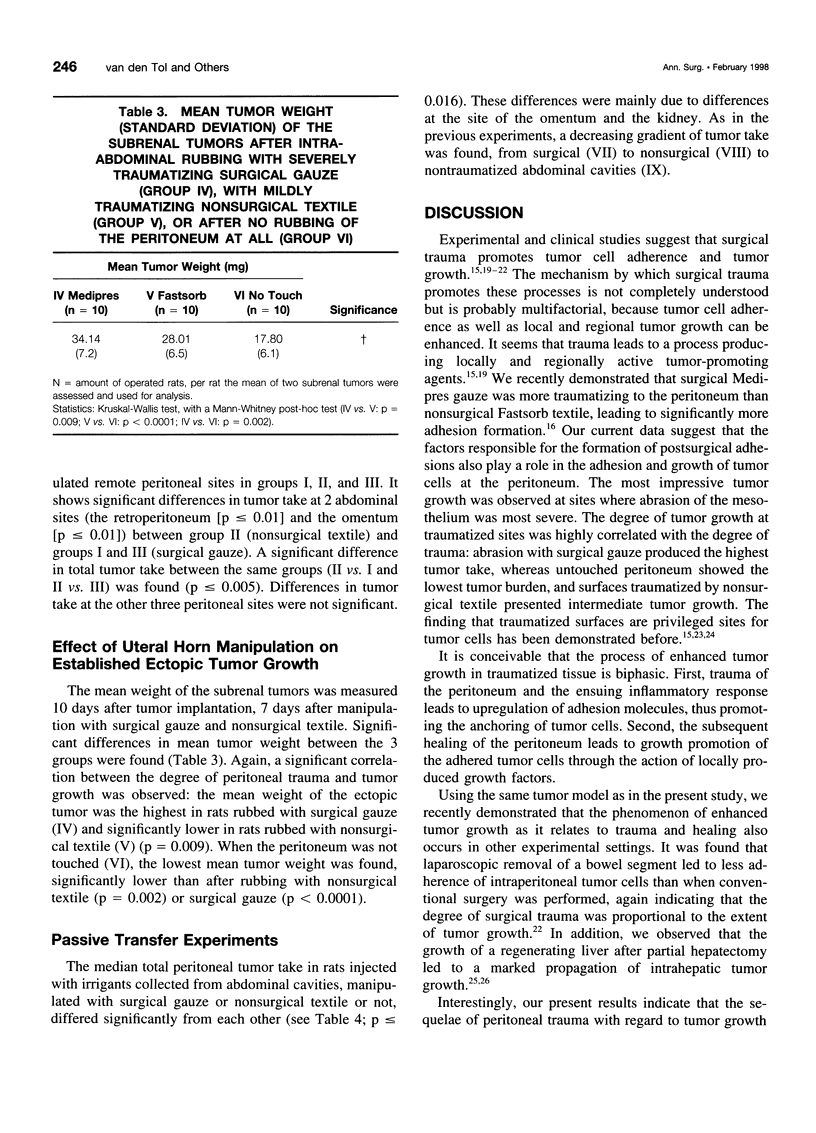
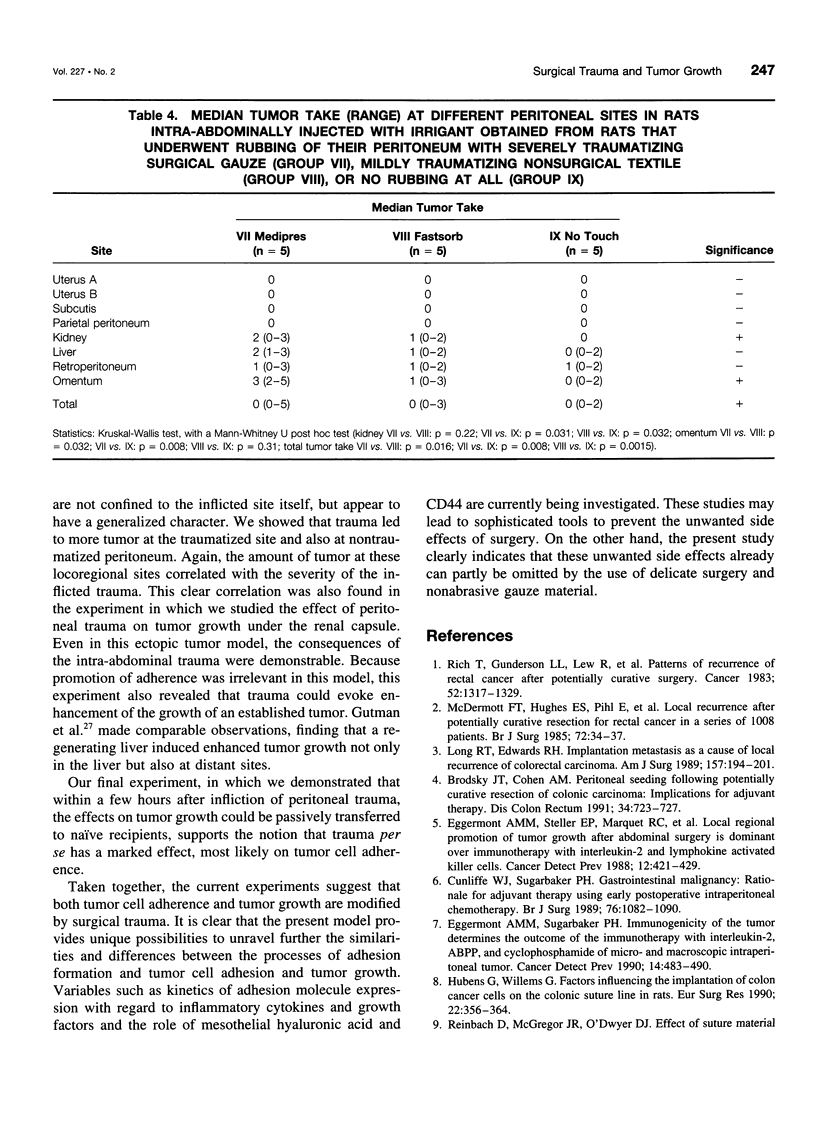
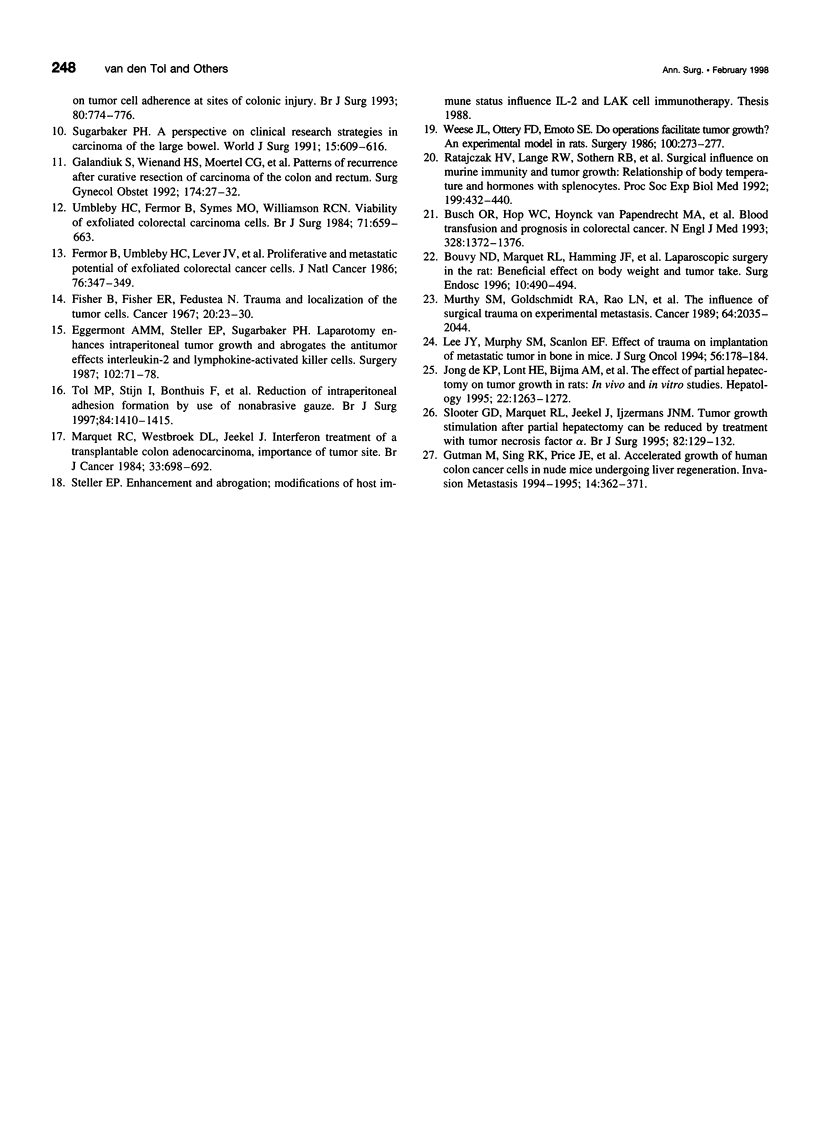
Selected References
These references are in PubMed. This may not be the complete list of references from this article.
- Bouvy N. D., Marquet R. L., Hamming J. F., Jeekel J., Bonjer H. J. Laparoscopic surgery in the rat. Beneficial effect on body weight and tumor take. Surg Endosc. 1996 May;10(5):490–494. doi: 10.1007/s004649910096. [DOI] [PubMed] [Google Scholar]
- Brodsky J. T., Cohen A. M. Peritoneal seeding following potentially curative resection of colonic carcinoma: implications for adjuvant therapy. Dis Colon Rectum. 1991 Aug;34(8):723–727. doi: 10.1007/BF02050360. [DOI] [PubMed] [Google Scholar]
- Busch O. R., Hop W. C., Hoynck van Papendrecht M. A., Marquet R. L., Jeekel J. Blood transfusions and prognosis in colorectal cancer. N Engl J Med. 1993 May 13;328(19):1372–1376. doi: 10.1056/NEJM199305133281902. [DOI] [PubMed] [Google Scholar]
- Cunliffe W. J., Sugarbaker P. H. Gastrointestinal malignancy: rationale for adjuvant therapy using early postoperative intraperitoneal chemotherapy. Br J Surg. 1989 Oct;76(10):1082–1090. doi: 10.1002/bjs.1800761030. [DOI] [PubMed] [Google Scholar]
- Eggermont A. M., Steller E. P., Marquet R. L., Jeekel J., Sugarbaker P. H. Local regional promotion of tumor growth after abdominal surgery is dominant over immunotherapy with interleukin-2 and lymphokine activated killer cells. Cancer Detect Prev. 1988;12(1-6):421–429. [PubMed] [Google Scholar]
- Eggermont A. M., Steller E. P., Sugarbaker P. H. Laparotomy enhances intraperitoneal tumor growth and abrogates the antitumor effects of interleukin-2 and lymphokine-activated killer cells. Surgery. 1987 Jul;102(1):71–78. [PubMed] [Google Scholar]
- Eggermont A. M., Sugarbaker P. H. Immunogenicity of the tumor determines the outcome of immunotherapy with interleukin-2, ABPP, and cyclophosphamide of micro- and macrometastatic intraperitoneal tumor. Cancer Detect Prev. 1990;14(4):483–490. [PubMed] [Google Scholar]
- Fermor B., Umpleby H. C., Lever J. V., Symes M. O., Williamson R. C. Proliferative and metastatic potential of exfoliated colorectal cancer cells. J Natl Cancer Inst. 1986 Feb;76(2):347–349. [PubMed] [Google Scholar]
- Fisher B., Fisher E. R., Feduska N. Trauma and the localization of tumor cells. Cancer. 1967 Jan;20(1):23–30. doi: 10.1002/1097-0142(1967)20:1<23::aid-cncr2820200103>3.0.co;2-p. [DOI] [PubMed] [Google Scholar]
- Galandiuk S., Wieand H. S., Moertel C. G., Cha S. S., Fitzgibbons R. J., Jr, Pemberton J. H., Wolff B. G. Patterns of recurrence after curative resection of carcinoma of the colon and rectum. Surg Gynecol Obstet. 1992 Jan;174(1):27–32. [PubMed] [Google Scholar]
- Gutman M., Singh R. K., Price J. E., Fan D., Fidler I. J. Accelerated growth of human colon cancer cells in nude mice undergoing liver regeneration. Invasion Metastasis. 1994;14(1-6):362–371. [PubMed] [Google Scholar]
- Hubens G., Willems G. Factors influencing the implantation of colon cancer cells on the colonic suture line in rats. Eur Surg Res. 1990;22(6):356–364. doi: 10.1159/000129122. [DOI] [PubMed] [Google Scholar]
- Lee J. Y., Murphy S. M., Scanlon E. F. Effect of trauma on implantation of metastatic tumor in bone in mice. J Surg Oncol. 1994 Jul;56(3):178–184. doi: 10.1002/jso.2930560311. [DOI] [PubMed] [Google Scholar]
- Long R. T., Edwards R. H. Implantation metastasis as a cause of local recurrence of colorectal carcinoma. Am J Surg. 1989 Feb;157(2):194–201. doi: 10.1016/0002-9610(89)90527-8. [DOI] [PubMed] [Google Scholar]
- Marquet R. L., Westbroek D. L., Jeekel J. Interferon treatment of a transplantable rat colon adenocarcinoma: importance of tumor site. Int J Cancer. 1984 May 15;33(5):689–692. doi: 10.1002/ijc.2910330521. [DOI] [PubMed] [Google Scholar]
- McDermott F. T., Hughes E. S., Pihl E., Johnson W. R., Price A. B. Local recurrence after potentially curative resection for rectal cancer in a series of 1008 patients. Br J Surg. 1985 Jan;72(1):34–37. doi: 10.1002/bjs.1800720115. [DOI] [PubMed] [Google Scholar]
- Murthy S. M., Goldschmidt R. A., Rao L. N., Ammirati M., Buchmann T., Scanlon E. F. The influence of surgical trauma on experimental metastasis. Cancer. 1989 Nov 15;64(10):2035–2044. doi: 10.1002/1097-0142(19891115)64:10<2035::aid-cncr2820641012>3.0.co;2-l. [DOI] [PubMed] [Google Scholar]
- Ratajczak H. V., Lange R. W., Sothern R. B., Hagen K. L., Vescei P., Wu J., Halberg F., Thomas P. T. Surgical influence on murine immunity and tumor growth: relationship of body temperature and hormones with splenocytes. Proc Soc Exp Biol Med. 1992 Apr;199(4):432–440. doi: 10.3181/00379727-199-43377. [DOI] [PubMed] [Google Scholar]
- Reinbach D., McGregor J. R., O'Dwyer P. J. Effect of suture material on tumour cell adherence at sites of colonic injury. Br J Surg. 1993 Jun;80(6):774–776. doi: 10.1002/bjs.1800800642. [DOI] [PubMed] [Google Scholar]
- Rich T., Gunderson L. L., Lew R., Galdibini J. J., Cohen A. M., Donaldson G. Patterns of recurrence of rectal cancer after potentially curative surgery. Cancer. 1983 Oct 1;52(7):1317–1329. doi: 10.1002/1097-0142(19831001)52:7<1317::aid-cncr2820520731>3.0.co;2-6. [DOI] [PubMed] [Google Scholar]
- Slooter G. D., Marquet R. L., Jeekel J., Ijzermans J. N. Tumour growth stimulation after partial hepatectomy can be reduced by treatment with tumour necrosis factor alpha. Br J Surg. 1995 Jan;82(1):129–132. doi: 10.1002/bjs.1800820144. [DOI] [PubMed] [Google Scholar]
- Sugarbaker P. H. A perspective on clinical research strategies in carcinoma of the large bowel. World J Surg. 1991 Sep-Oct;15(5):609–616. doi: 10.1007/BF01789207. [DOI] [PubMed] [Google Scholar]
- Umpleby H. C., Fermor B., Symes M. O., Williamson R. C. Viability of exfoliated colorectal carcinoma cells. Br J Surg. 1984 Sep;71(9):659–663. doi: 10.1002/bjs.1800710902. [DOI] [PubMed] [Google Scholar]
- Weese J. L., Ottery F. D., Emoto S. E. Do operations facilitate tumor growth? An experimental model in rats. Surgery. 1986 Aug;100(2):273–277. [PubMed] [Google Scholar]
- de Jong K. P., Lont H. E., Bijma A. M., Brouwers M. A., de Vries E. G., van Veen M. L., Marquet R. L., Slooff M. J., Terpstra O. T. The effect of partial hepatectomy on tumor growth in rats: in vivo and in vitro studies. Hepatology. 1995 Oct;22(4 Pt 1):1263–1272. [PubMed] [Google Scholar]
- van den Tol M. P., van Stijn I., Bonthuis F., Marquet R. L., Jeekel J. Reduction of intraperitoneal adhesion formation by use of non-abrasive gauze. Br J Surg. 1997 Oct;84(10):1410–1415. [PubMed] [Google Scholar]


